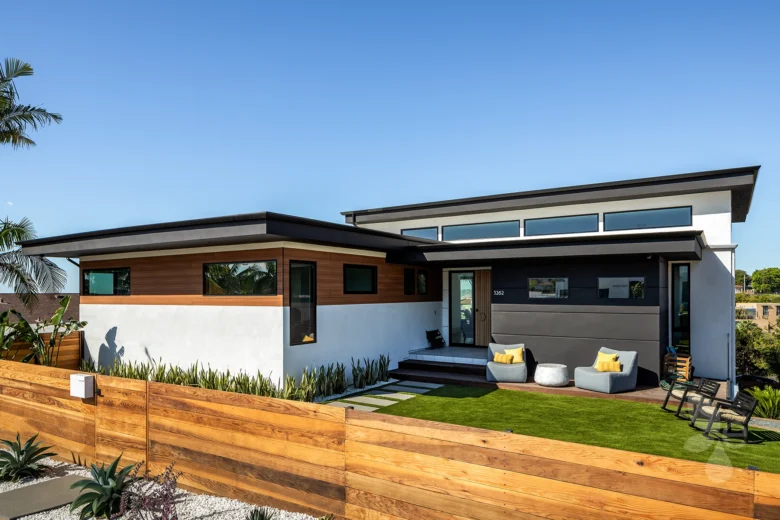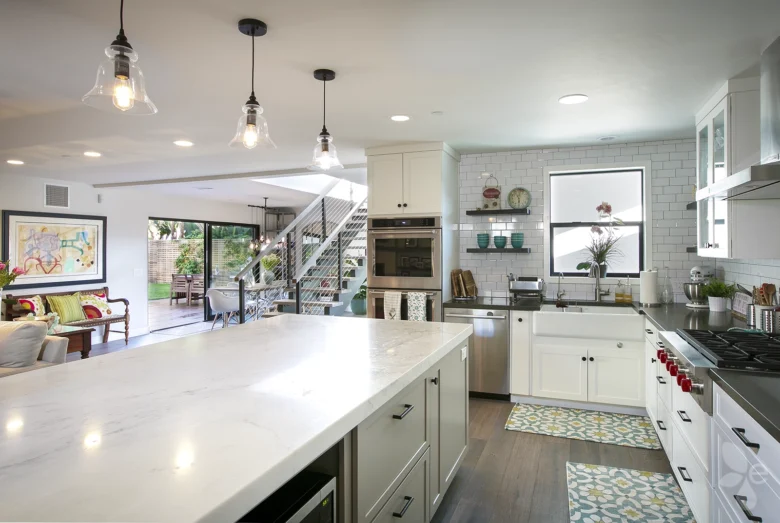The term “modern architecture” is often used in the housing industry. You will often hear realtors use the term to generate interest around properties they are trying to move. They may use it as a buzzword so people will check out their listings.
You may have an idea of what modern architecture is, but you may have a tough time elaborating on that. The specific concepts associated with that style may not be things you can clearly define or identify.
Throughout this article, we highlight the different elements and characteristics that have come to define modern architecture. On top of that, we will also use this article to detail some notable examples of that design philosophy.
Going with a modern design may sound like something you want to do with your property. Continue with this article and find out if you should follow modern design principles for your home.
Evolution of Modern Architecture
To develop a good understanding of modern architecture, we first need to take a look at its origins. Designs that were emblematic of this particular philosophy first started to emerge back in the late 1800s. At the 1893 World’s Fair in Chicago, architect Louis Sullivan showed off the structures that would be known as the first-ever skyscrapers.
Per this article from Masterclass, those skyscrapers that Sullivan debuted at the World’s Fair ended up serving as the inspiration for numerous other structures, including the office buildings that we see populating metro centers today. Sullivan’s decision to emphasize functional design truly resonated with other architects.
In 1919, Walter Gropius founded the Bauhaus School in Germany. The foundation of the Bauhaus School proved to be a seminal moment in the development of modern architecture. Thanks to the Bauhaus School, aspiring architects fully grasped the concepts of modern architecture. They could implement its ideals in their work.
Architect Philip Johnson would also make his own significant contributions to the modernist movement in 1932. Johnson’s contributions were mainly about refining the concepts of this architectural approach. Johnson specifically talked about moving away from ornamentation and integrating innovations into structural designs.
It may surprise some people to learn that the idea of modern architecture has been around for so long. Still, that may become less surprising when you start to think about the principles of that philosophy. It makes sense that modern design became popular, and it makes even more sense that we utilize it to this day.
Defining Elements of Modern Architecture
Now that we have more background on modern architecture and how it developed over several decades, we can turn our attention to different matters. We can specifically focus on the elements of modern design. Knowing about those elements will allow you to identify the modern buildings present in your city.
You can also integrate those elements into your project to create the exact home you have always wanted. Check out the characteristics of modern architecture and see how you can work them into your home building project.
Form Follows Function
When architect Louis Sullivan talked about his skyscrapers, he talked about adopting a certain design philosophy. He specifically mentioned the idea that “form follows function”. Whether he meant it or not, those words ended up inspiring a new approach to architecture. It inspired more architects to prioritize functional design in their creations.
The pursuit of functional design is why you can see many examples of modern architecture that include asymmetrical elements. Architects do not worry too much about creating something aesthetically balanced as long as the design makes sense from a functional standpoint.
Homes that follow modern design often end up somewhat lower in their height. That is an intentional element of modern design. Houses are not built any taller than they need to be. Also, they often make roofs of modern structures flat to be functional. The large roof overhang also has a practical application since it provides shade and protection from the elements.
Minimalist Design
Minimalism is another pillar of modern architectural design. It is related to the emphasis placed on functional design. If a certain element does not add a real function to the structure beyond being an ornament, then there is no need for it to be there.
You will not see design flourishes added to staircase railings, doors, or other home fixtures. In a way, the decision to move away from those decorative elements has also given modern architecture its own distinctive look.
There is a purity to the way modern design looks that can make it highly appealing. Plus, if you are someone who dislikes clutter, modern design will work for you. Modern architecture can also affect the color scheme of your home. More often than not, neutral colors are used in modern design because they emphasize the minimalist approach further.
Open Interiors
The open concept kitchen that has become incredibly popular in recent years has roots in modern design. Yet again, it is worth mentioning that modern architecture is largely about functional design. Walls that separate rooms may not be deemed necessary. They may be needless barriers. In place of those walls, they keep the structure open. By doing so, occupants have more space to use.
You can use the available space to house different appliances or pieces of furniture. You can also use it to create the open concept kitchen that we mentioned a few sentences ago. Modern homes allow you to be more flexible when designing because of how open they are. You can quickly change your home interior since there are not a lot of fixtures that get in your way.
Clean Lines
Structural elements featured in modern architecture have a prominent feel to them. Why is that the case? You can point to the lines that create that emphasis. The modern architecture features many clean lines. These lines are essential for promoting functional design and minimalism. They are essential for creating the looks we associate with this design philosophy. The clean lines also promote consistency. They help ensure that the final product will look exactly as intended.
Frequent Usage of Certain Materials
Lastly, you can tell that a structure follows modern design principles based on the materials used to complete it. Glass is probably the material most people think of right away when they are trying to envision a modern structure. They envision the glass walls lining the perimeter and creating something quite spectacular.
Beyond glass, other materials commonly used for modern include aluminum, brick, concrete, natural stone, steel, and tiles. As ArchDaily points out, tile, tile is a popular choice for modern homes because you can use it in so many places. You can use it on your floors, walls, and even your countertops. Some may also be surprised that they use wood to create modern structures.
However, that makes more sense when you see how versatile and functional wood is as a building material. It is important to note that modern architecture places no limits on what materials you can use to create modern structures. Even so, the materials we mentioned here are the ones you will see used repeatedly in those creations.
What Are Examples of Modern Architecture?
Are you looking for more concrete sources of inspiration as you decide on what you want your home to be? If so, you may benefit from learning more about some specific examples of modern architecture. For this section of the article, we highlight some of the popular modern designs for homes. Go through them and see if any design piques your interest.
Modern Farmhouse Design
Let’s start by taking a closer look at the modern farmhouse design. This design could fit your property if you want something a bit more traditional. With a modern farmhouse, you start with the classic farmhouse design and refine it as needed. Often, that means opening up the interior to create more space. Vertical space may also be created by opening up the rafters.
Neutral colors are also featured prominently in modern farmhouses. They help transform the appearance of the farmhouse and give it a more modern feel. Clean lines also define the structure of the modern farmhouse. Modern farmhouses bring together the best elements of classic and contemporary design to create a home that is cozy and practical.
Contemporary Design
People often use contemporary and modern design interchangeably, but is that appropriate? Are both terms referring to the same design philosophy? As it turns out, they are not the same design principles. There are enough dissimilarities between them that you could tell which is which.
For instance, modern design mainly utilizes neutral colors. On the other hand, the contemporary design prioritizes contrasting colors. You may see black and white pairings, along with bright colors set against a neutral backdrop in contemporary design.
You will also find that contemporary design embraces ornamental elements more than modern architectural design. You can add pieces purely for decorative purposes; that does not happen with the modern approach. Curves are also more prominent in contemporary design. The need to create clean lines is de-emphasized with contemporary design to be more flexible.
Contemporary Coastal Design
The coastal design emphasizes natural light, gorgeous views, cleanliness, linens, woven items, and a beach-inspired color palette. When you are staying in a home that features a coastal design, it almost feels like an extension of the beach instead of something separate.
The look of a coastal design is stunning, but if you want to switch things up, you could adopt the contemporary coastal approach. Contemporary coastal design is what you get when you marry modern architecture with coastal sensibilities. That marriage creates a new color palette.
More focus is placed on neutral hues, although there is still a general goal of using those colors to create a bright interior. Accessorizing is also toned down significantly in contemporary coastal design. Removing clutter is central to modern design, so you cannot overload your home with too many decorative pieces.
Stick to a few pieces of furniture and use them to accent your overall décor instead. Installing floor-to-ceiling glass walls is also a smart idea to feature a contemporary coastal design. Those walls will enable you to enjoy the beautiful views and also allow natural light to enter your home.
Beach Bungalow Design
The beach bungalow design shares a lot of similarities with the contemporary coastal approach. Both design philosophies take inspiration from the beach, and they prominently feature natural light along with breathtaking views. However, they differ in terms of what they are trying to achieve.
Contemporary coastal homes try to blend into the scenery. Meanwhile, beach bungalows serve as contrasting elements to their natural surroundings. Beach bungalows look more like modern homes, but they do feature a few beach-inspired elements as well.
Mid-Century Modern Design
To finish this list of variations on modern architecture, we have the mid-century modern design. Mid-century modern design focuses on combining man-made and natural elements. They designed certain elements of the home in such a way that they blur the line between the interior and exterior portions. You will also notice that design philosophy in terms of the colors used.
Neutral hues are used as the base colors, while brighter, natural colors serve as accents. Boldly designed pieces of furniture made from natural materials are also staples of mid-century modern design. Still, you cannot use too many of those items since mid-century modern design continues to emphasize minimalism.
Expert Help for All Your Modern Architecture Needs
A modern home could be exactly what you are looking for. If you are interested in building one, we at Eco Minded Solutions can help you out. Contact us today and let’s build a home that embodies the beauty of modern architecture!


